
The Sesiidae or clearwing moths are a diurnal moth family in the order Lepidoptera known for their Batesian mimicry in both appearance and behaviour of various Hymenoptera.

The ash borer, or lilac borer, is a clearwing moth in the family Sesiidae. It is found throughout North America and can be a pest of ash and lilac.
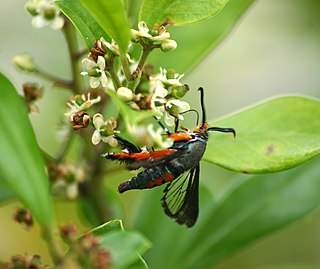
The squash vine borer is a diurnal species of sesiid moth. The moth is often mistaken for a bee or wasp because of its movements, and the bright orange hind leg scales. The females typically lay their eggs at the base of leaf stalks, and the caterpillars develop and feed inside the stalk, eventually killing the leaf. They soon migrate to the main stem, and with enough feeding damage to the stem, the entire plant may die. For this reason, it is considered a pest that attacks cultivated varieties of squash, zucchini, pumpkin, and acorn squash. The squash vine borer is native to North America, with some reports as far south as Brazil and Argentina. It lives in most temperate North American states, except the Pacific coast. Southern states have two broods a year.
Pseudosesia isozona is a moth of the family Sesiidae. It is found in Queensland, Australia.
Ichneumenoptera chrysophanes, the clearwing persimmon borer, is a moth of the family Sesiidae. It is found from Cairns in Queensland to Canberra in the Australian Capital Territory.

Sannina is a genus of moths in the family Sesiidae.

Bembecia is a genus of moths in the family Sesiidae.

Synanthedon scitula, the dogwood borer or pecan borer, is a moth that is a pest of many plants including the dogwood and pecan. It is notorious due to the severity of damage it can cause and its widespread geographical distribution.

Synanthedon pictipes, the lesser peachtree borer, is a moth of the family Sesiidae. It is known from the eastern half of Canada and the United States westward to Minnesota in the north and eastern Texas in the south.
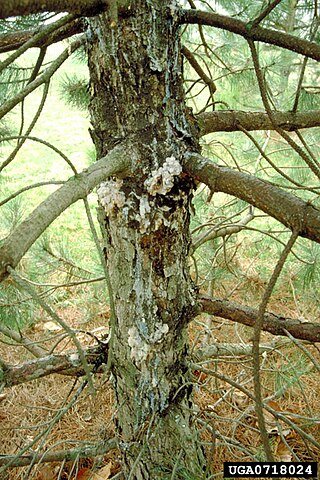
Synanthedon pini, the pitch mass borer, is a moth of the family Sesiidae. The pitch mass borer occurs on spruce and pine in eastern North America. It does not kill trees, but the pitch-filled larval tunnels in the wood cause defects in the lumber.

Paranthrene robiniae, the western poplar clearwing, is a moth of the family Sesiidae. It is found from sea level to near the timber line from Alaska southward along the Pacific Coast to southern California and throughout the Rocky Mountains into the desert southwest and as far east as Kansas and North Dakota.
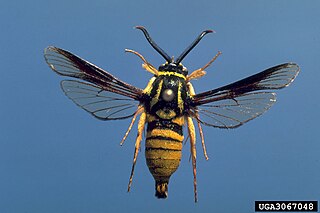
Paranthrene simulans, the red oak clearwing borer, hornet clearwing or oak clearwing borer, is a moth of the family Sesiidae. It is found in eastern North America, from Nova Scotia to Florida, west to Minnesota, Missouri and Mississippi.

Synanthedon rileyana, the horsenettle borer or Riley's clearwing moth, is a moth of the family Sesiidae. It is found in the United States, including Arkansas, Arizona, Missouri, Oklahoma, North Carolina and Pennsylvania.
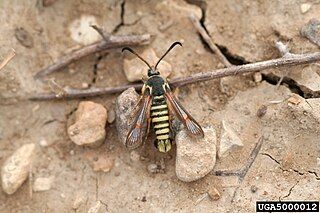
Carmenta mimuli, the coronopus borer, is a moth of the family Sesiidae. The dark form is the typical form and is found in Arizona. The whitish form is non-typical and is known from the south-western United States, from Kansas to Arizona.
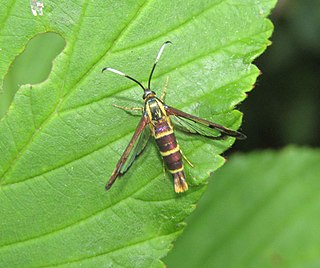
Carmenta bassiformis, the eupatorium borer moth or ironweed clearwing moth, is a moth of the family Sesiidae. It was described by Francis Walker in 1856, and is found in the United States from Massachusetts to Florida, west to Wisconsin, Kansas and Texas.
Carmenta theobromae, the cocoa fruit borer, is a moth of the family Sesiidae. It was described by August Busck in 1910, and is known from Colombia and Venezuela.

Melittia gloriosa, the glorious squash vine borer or manroot borer, is a moth of the family Sesiidae. It is known from North America, including Arizona, California, New Mexico, Oklahoma and Texas.

Sesia tibialis, the American hornet moth, poplar clearwing borer or cottonwood crown borer, is a moth of the family Sesiidae. It is known from North America, including British Columbia, Colorado, Utah, Michigan, Montana, Washington, California and Arizona.

Vitacea polistiformis, the grape root borer, is a moth of the family Sesiidae. It is found throughout the midwest of the United States, south to Florida and Texas. It is the most serious threat to grapes in Florida.

Hystrichophora taleana, the indigobush twig borer, is a moth of the family Tortricidae. It is known from the United States where it was found in Washington and Sharkey counties in Mississippi and Chico County in southeastern Arkansas.



















